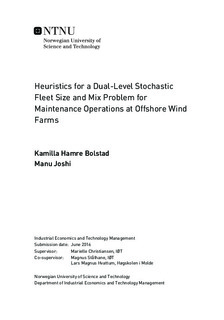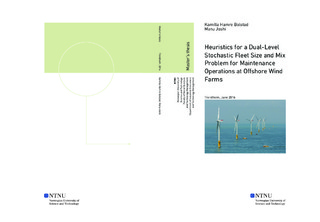| dc.description.abstract | Due to high costs, the offshore wind industry is currently not economically viable on its own. For offshore wind to be a profitable future energy source, it is therefore necessary to find methods for reducing costs. Operations and maintenance at offshore wind farms is an important cost driver, and accounts for 20 - 25% of the lifetime costs of wind farms today. Vessel fleets used to conduct maintenance operations at offshore wind farms are expensive to acquire and operate. A vessel fleet that is capable of operating in rough weather conditions gives a high degree of accessibility to wind farms, and hence allows wind farm owners to reduce revenue loss from unplanned production stops. The potential savings from determining an optimal fleet size and mix for conducting maintenance at offshore wind farms can therefore be substantial.
This thesis studies the strategic problem of finding a cost optimal fleet size and mix for conducting maintenance operations at offshore wind farms (DLPOW). A dual-level stochastic model has been developed, which accounts for both long-term strategic uncertainty and short-term tactical uncertainty in one optimization model. The model supports wind farm owners in making strategic decisions regarding the amount, placement, charter length and types of vessels to long- and short-term charter, to meet maintenance demand throughout the lifetime of a wind farm. To evaluate the quality of strategic fleet size and mix decisions, the model also considers the tactical deployment decisions of how to utilize the fleet to conduct maintenance operations. The model accounts for strategic uncertainties that have not been considered in previously developed optimization models for offshore wind, such as uncertainty related to: long-term trends in electricity prices and subsidy levels, stepwise development of wind farms, and technology development in the vessel industry.
Several solution methods have been developed to solve the DLPOW. From computational testing, it can be seen that the use of a standard optimization solver as a solution method is impractical for anything but small instances due to memory limitations. In order to solve real-life instances, a heuristic solution method based on the Greedy Randomized Adaptive Search Procedure (GRASP) has been developed. The reactive metaheuristic developed exploits the block-separable structure of the DLPOW to decompose the problem into a master problem and many independent subproblems. The reactive GRASP constructs strategic fleet size and mix solutions for solving the master problem. A simple Greedy Tactical Heuristic, embedded in the GRASP, solves the subproblems of tactical fleet deployment to evaluate the objective function value of a given fleet solution. The performance of the reactive GRASP has been evaluated by comparing solution time and quality from the GRASP to the equivalent values obtained from a standard optimization solver. The results show that the GRASP consistently provides good solutions for the DLPOW, and finds higher quality solutions for 24 of 29 tested instances, compared to the solver. Furthermore, the GRASP is able to solve significantly larger problems within a considerable shorter amount of time. | |

